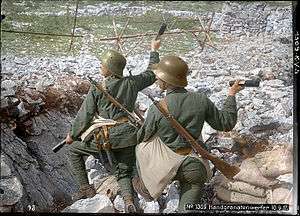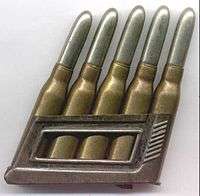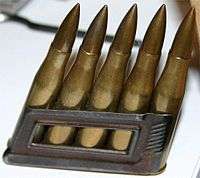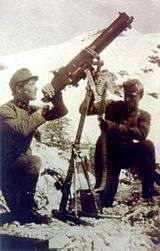Mannlicher M1895
The Mannlicher M1895 (German: Infanterie Repetier-Gewehr M.95, Hungarian: Gyalogsági Ismétlő Puska M95; "Infantry Repeating-Rifle M95") is a straight pull bolt-action rifle, designed by Ferdinand Ritter von Mannlicher that used a refined version of his revolutionary straight-pull action bolt, much like the Mannlicher M1890 carbine. It was nicknamed the Ruck-Zuck-Gewehr by Austrian troops (ruck-zuck spoken as "roock-tsoock", in common language meaning "backpack rifle") and "Ta-Pum" by Italian troops who even wrote a song about it during World War I.
| Infanterie Repetier-Gewehr M.95 Gyalogsági Ismétlő Puska M95 (Infantry Repeating-Rifle M95) | |
|---|---|
 Mannlicher M1895 Rifle. From the collections of the Swedish Army Museum. | |
| Type | Bolt-action rifle |
| Place of origin | Austria-Hungary |
| Service history | |
| In service | 1895–1945 1895–1918 (Austria-Hungary) |
| Used by | See Users |
| Wars | Boxer Rebellion First Balkan War Second Balkan War World War I Russian Civil War[1] Austro-Slovene conflict in Carinthia Revolutions and interventions in Hungary Polish-Soviet War Austrian Civil War Second Italo-Ethiopian War Spanish Civil War[2] Sudeten German uprising 1938 World War II Greek Civil War[3] 1948 Arab–Israeli War[3] |
| Production history | |
| Designer | Ferdinand Mannlicher |
| Designed | 1895 |
| Manufacturer | 1896–1918: Œ.W.G. in Steyr 1897–1918: F.G.GY. in Budapest 1918–1920: Zbrojovka Brno |
| Produced | 1896–1920 |
| No. built | approx. 3,500,000[4] |
| Variants | See Variants |
| Specifications (M95 Long Rifle) | |
| Mass | 3.78 kilograms (8.3 lb) |
| Length | 1,272 millimetres (50.1 in) |
| Barrel length | 765 millimetres (30.1 in) |
| Cartridge | M95: 8×50mmR Mannlicher M95/30 & 31.M: 8×56mmR M95/24 & M95M: 8×57mm IS |
| Action | Straight-pull bolt action |
| Rate of fire | approx. 20–25 rounds/min |
| Muzzle velocity | M93 (8×50mmR): 620 m/s (2,000 ft/s) M30 (8×56mmR): 720 m/s (2,400 ft/s) |
| Feed system | 5-round en bloc clip (stripper clip in M95/24 and M95M), internal box magazine |
| Sights | Rear V-notch flip-up sight and front post (telescopic sight on sniper variant) |
Originally they were chambered for the round-nosed 8×50mmR cartridge, but almost all were rechambered to accept the more powerful spitzer 8×56mmR cartridge in the 1930s.
Method of Operation
The M1895 is unusual in employing a straight-pull bolt action, as opposed to the more common rotating bolt-handle of other rifles. It combines a two lug rotating bolt head, similar in construction to that found on a Mauser rifle with a pair of helical grooves cut in the bolt body to turn the back and forth movement of the bolt handle and body into the rotational movement of the bolt head. The extractor performs both the usual function, and also has a tail attached which interfaces with slots on the cam surfaces of the bolt head to prevent the bolt head from rotating as a result of the striker's spring pressure once it has been unlocked.[5]
The angle of the cam surfaces in the bolt and bolt body is different from the angle at which the locking recesses are cut in the receiver of the rifle, the result is that the first 20 mm of travel of the bolt body results in the rotation of the bolt head but only about 3 mm of rearward movement, this gives mechanical advantage to the system and accomplishes primary extraction.
The result of this is that the user can pull the bolt back and forth in two movements rather than the up-back-forward-down of conventional turn bolt rifles. It is consequently renowned for combining relatively high rate of fire (around 20–25 rounds per minute) with reliability and sturdiness, although this requires decent care and maintenance. During Austro-Hungarian trials in 1892, rifles survived torture testing of firing 50,000 rounds without any form of lubrication.[6]
The rifle is loaded by means of a five-round en-bloc clip, which when loaded with cartridges, is pressed into the magazine of the rifle, where it is retained and acts at the feed lips of the magazine. When the last of the five rounds has been chambered, there is no longer anything retaining the clip in the magazine and it falls out a port in the bottom due to gravity. There is a button in the front of the trigger guard which allows the user to eject a partially or fully loaded clip from the magazine when the bolt is open to unload the weapon. The clip will be ejected from the weapon quite energetically as the full force of the follower spring will be pressing against it.
The rifle is not designed to be loaded by any other means but the en-bloc clip. Attempts to single feed the rifle in absence of proper clips may cause damage to the extractor as it is not designed with enough travel to overcome the large rims of the 8x50mmR and 8x56mmR cartridges used in the M1895 unless they are fed under the extractor from the clip.
History

It was initially adopted and employed by the Austro-Hungarian Army throughout World War I, and retained post-war by both the Austrian and Hungarian armies. The main foreign user was Bulgaria, which, starting in 1903, acquired large numbers and continued using them throughout both Balkan and World Wars. After Austria-Hungary's defeat in World War I, many were given to other Balkan states as war reparations. A number of these rifles also saw use in World War II, particularly by second line, reservist, and partisan units in Romania, Yugoslavia, Italy, and to lesser degree, Germany. Post war many were sold as cheap surplus, with some finding their way to the hands of African guerrillas in the 1970s and many more being exported to the United States as sporting and collectible firearms. The M1895 bolt also served as an almost exact template for the ill-fated Canadian M1905 Ross rifle, though the later M1910 used a complicated interrupted-thread instead of two solid lugs.
Ammunition
The M1895 was originally chambered in the 8mm M.1893 scharfe Patrone (8×50mmR Mannlicher) cartridge. Between the world wars, both Austria and Hungary converted the majority of their rifles to fire the more powerful 8×56mmR round.
Yugoslavia[7] converted at least some of their captured M1895s to 7.92×57mm Mauser, fed by stripper clips instead of the original model's en bloc clip system. This conversion was designated M95/24 and M95M. The M95/24 is often mistakenly attributed to Bulgaria, but 8×57mm IS was never a standard cartridge of the Bulgarian military.[8] These conversions are prized by collectors for their relative scarcity and chambering in a commonly available round, but suffer from a fragile extractor and a lack of replacement parts.
Variants
For the post World War I conversions see Conversions.
Rifle
The "Infantry Repeating-Rifle M1895" (German: Infanterie Repetier-Gewehr M1895) was the basic variant. It was chambered for the 8×50mmR Mannlicher cartridge. Its iron sights were graduated 300–2600 paces (225–1950 m). It was used during World War I by the majority of the Austro-Hungarian Army troops.
Stutzen
This stutzen or short rifle (official designation German: Repetier-Stutzen M1895; "Repeating-Stutzen M1895") was mainly used by special troops (i.e. storm troops) during World War I. It chambered the 8×50mmR Mannlicher cartridge. Its sights were graduated 500–2400 paces (375–1800 m).
Weight: 3.09 kilograms (6.8 lb)
Length: 1,003 millimetres (39.5 in)
Barrel length: 500 millimetres (20 in)
Carbine
The carbine (official designation German: Kavalerie Repetier-Carabiner M1895; "Cavalry Repeating-Carbine M1895") was chambered 8×50mmR Mannlicher and used by cavalry units of the Austro-Hungarian Army as a replacement of the Mannlicher M1890 carbine. The sights were graduated 500–2400 paces (375–1800 m). Although it originally didn't have bayonet lugs, during World War I it was fitted with stutzen-like front barrel band with bayonet lugs after mounted cavalry units were found ineffective.
Sniper rifle

The main difference from the standard rifle and sniper was the telescopic sight mount. The scope was mounted slightly to the left so the rifle could be fed by en bloc clip. Approximately 6,000 long and short barreled sniper rifles were made in the years 1915–1918.[9]
Conversions
The M95/30 was a conversion in the First Austrian Republic by Steyr-Mannlicher during 1930–1940. These rifles carry the letter S meaning Spitzer stamped on the barrel. Main modification was the rechambering to 8×56mmR cartridge. Other changes were the conversion of ladder sights from the older pace unit to meters and addition of a brass front sight protector. Many long rifles were cut down to Stutzen length. Most of M95/30s were sent to Bulgaria during 1938–40, where front sight protectors were removed.[10]
The 31.M or M95/31 was a conversion done in the Kingdom of Hungary. Rifles were converted 1931–1935 by FÉG in Budapest and carry the letter H meaning Hegyes Töltény (pointed bullet) stamped on top of the chamber. The conversion included rechambering to the new 8×56mmR pointed bullet cartridge, new metric ladder sights and the addition of a front-sight protector. Long rifles were cut down to carbine length and designated 31/a.M. They were not used for much time and were withdrawn to storage when the new 35M rifle was introduced. Some were reissued during World War II. A small number were rechambered but were not cut down for the Hungarian Governmental Guards; these had special long bayonets.[11]
The M95M or M95/24 was a conversion to 7.92×57mm cartridge by the Kragujevac Arsenal in the Kingdom of Yugoslavia. These rifles feature Yugoslavian M24 Mauser barrels, sights, similar handguards and are fed by five-round stripper clips. Their extractors are prone to breakage when being fired single-shot. Some of these rifles were found in the Kingdom of Greece by the German forces during World War II and were mistakenly attributed Greek origin.[12][13]
Summary
Source:[14]
| Cartridge | Length | Weight | Sling Swivels | Bayonet Lug | Notes | |
|---|---|---|---|---|---|---|
| Rifle Model 1895 | 8×50mmR | 128.2 cm (50.5 in) | 3.63 kg (8.0 lb) | Under | Yes | |
| Carbine Model 1895 | 8×50mmR | 100 cm (39 in) | 2.95 kg (6.5 lb) | Side | No | 7 in (18 cm) gap between front and rear barrel bands |
| Stutzen Model 1895 | 8×50mmR | 100 cm (39 in) | 3.13 kg (6.9 lb) | Under | Yes | 5 in (13 cm) gap between front and rear barrel bands |
| Carbine Model 1895 with Stutzen lug | 8×50mmR | 100 cm (39 in) | 3.18 kg (7.0 lb) | Side | Yes | 7 in (18 cm) gap between front and rear barrel bands |
| Carbine-Stutzen Model 1895 | 8×50mmR | 100 cm (39 in) | 3.22 kg (7.1 lb) | Either | Yes | 5 in (13 cm) gap between front and rear barrel bands |
| Stutzen-Carbine Model 1895 | 8×50mmR | 100 cm (39 in) | 3.27 kg (7.2 lb) | Both | Yes | 7 in (18 cm) gap between front and rear barrel bands |
| Rifle Model 1895/30 | 8×56mmR | 128.2 cm (50.5 in) | 3.63 kg (8.0 lb) | Under | Yes | |
| Stutzen Model 1895/30 | 8×56mmR | 100 cm (39 in) | 3.22 kg (7.1 lb) | Either | Yes | |
| Stutzen Model 1895/30 from Long Rifle | 8×56mmR | 100 cm (39 in) | 3.22 kg (7.1 lb) | Either | Yes | Long rifle rear sight |
| Rifle M95M and M95/24 | 7.92×57mm | 110 cm (43 in) | 3.86 kg (8.5 lb) | Both | Yes | |
Accessories
Bayonet

There were two main variants of the bayonet; the first one was the standard bayonet, the second one was the NCO variant that featured a hooked quillion and a golden lanyard. The overall length was 360 millimetres (14 in) and the blade was 248 millimetres (9.8 in) long. The bayonet was unusual in that the edge faced upwards when mounted on the rifle. Majority of them were made by Œ.W.G. and F.G.GY. Bayonets were originally not serial numbered.
Late in World War I resources were limited and they started manufacturing replacement (German: Ersatz) bayonets. These were fast to produce, cheap and made completely out of metal.[15]
Night sights
A number of Model 1916 night (Luminous) sights were issued during World War I.[16] The rear night sight is a small brass plate that is placed underneath the rear sight leaf. The front sight clamps around the rifle's front sight base.[17]
Wire destroyer
A Drahtzerstörer or "wire destroyer" device for Mannlicher type firearms was also sometimes issued with the rifle during World War I. During assaults, when soldiers would run into barbed wire obstacles, the "wire destroyer" would grab one of the wires and the soldier would shoot through it. It could only be used with a mounted bayonet.
Various other improvised wire destroyers existed, some originally designed for the Mosin–Nagant rifle that were captured on the Eastern front were easily modified to fit the M95. Some were also crafted by military blacksmiths.[18]
Users




.svg.png)


.svg.png)

.svg.png)
.svg.png)
.svg.png)
.svg.png)
_crowned.svg.png)

.svg.png)
.svg.png)
.svg.png)


.svg.png)


.svg.png)
See also
- Mannlicher M1890 Carbine
- Mannlicher M1888
- Weapons of the Austro-Hungarian Empire
- M1895 Lee Navy – An American straight-pull rifle
- Ross rifle – A Canadian straight-pull rifle
References
- Scarlata, Paul (20 November 2014). "Russian rifles of the great war, revolution & civil war—part I". Shotgun News. Archived from the original on 27 September 2015. Retrieved 19 September 2015.
- "spanishcivilwar1". Retrieved 10 October 2014.
- "Moschetto M95 carbine postwar". wwiiafterwwii.wordpress.com. 20 May 2015.
- John Walter (25 March 2006). Rifles of the World. Krause Publications. p. 265. ISBN 0-89689-241-7. Retrieved 9 September 2014.
- "Steyr-Mannlicher Modell 1895 rifle - Arms of the First World War - Royal Armouries collections". Royal Armouries collections. Retrieved 20 June 2018.
- "Mannlicher Model 1895 Infantry Rifle". MANOWAR'S HUNGARIAN WEAPONS & HISTORY.
- "Yugoslavian Mannlicher M.95 Rifles and Carbines". Manowar's Hungarian Weapons & History. Retrieved 22 June 2012.
- "Bulgarian Mannlicher M.95 Rifles and Carbines". Manowar's Hungarian Weapons & History. Retrieved 22 June 2012.
- "[The Mannlicher family]". Revija Obramba (in Slovenian). 13 (12). December 2003. ISSN 0353-9628.
- http://www.hungariae.com/Mann9530.htm
- http://www.hungariae.com/Mann31.htm
- http://www.hungariae.com/Mann95Se.htm
- "Archived copy". Archived from the original on 14 July 2014. Retrieved 14 June 2014.CS1 maint: archived copy as title (link)
- "Archived copy". Archived from the original on 27 March 2015. Retrieved 8 January 2015.CS1 maint: archived copy as title (link)
- "Austrian Ersatz Bayonets". Retrieved 10 October 2014.
- Ortner, Mario Christian (2006). Storm Troops. Militaria Verlag.
- "Mannlicher M95 Rifles and Carbines Accessories". hungariae.com. 2014. Retrieved 10 February 2015.
- Ortner, Mario Christian (2006). Storm Troops. Militaria Verlag.
- "Mannlicher M.95-type Rifles and Carbines, Albania". Retrieved 10 October 2014.
- "Czech Mannlicher M.95-type Rifles and Carbines". Retrieved 15 April 2015.
- Scarlata, Paul (August 2017). "Czechoslovak Weapons of World War II: part 1". Firearms News.
- "Finnish Mannlicher M.95-type Rifles and Carbines". Retrieved 10 October 2014.
- Scarlata, Paul (1 March 2009). "Ethiopian military rifle cartridges: Part 2: from Mauser to Kalashnikov". Shotgun News.
- "German Mannlicher M.95 Stutzens & Carbines". Retrieved 10 October 2014.
- "Greek Austro-Hungarian Mannlicher M.95 Rifles and Carbines". Retrieved 10 October 2014.
- "Mannlicher M95-type Rifles and Carbines". Retrieved 10 October 2014.
- "Rifle: Austro-Hungarian Steyr-Mannlicher M.95". C&Rsenal. Archived from the original on 22 December 2016. Retrieved 15 April 2015.
- "Karabin i karabinek 8 mm wz.1895 "Mannlicher" – Kampania Wrześniowa 1939.pl". Kampania Wrześniowa 1939. Retrieved 5 June 2012.
- "Mannlicher Yasnikov M.95-type Automatic Rifle Prototype". Retrieved 10 October 2014.
- Jowett, Philip (20 November 2013). China's Wars: Rousing the Dragon 1894-1949. General Military. Osprey Publishing. p. 40. ISBN 9781782004073.
- "Polish Austro Hungarian Mannlicher Rifles and Carbines". Retrieved 10 October 2014.
- "WorldWar2.ro". Retrieved 10 October 2014.
- А. Б. Жук. Энциклопедия стрелкового оружия: револьверы, пистолеты, винтовки, пистолеты-пулеметы, автоматы. М., АСТ – Voyenizdat, 2002, p. 587
- "Mannlicher Yasnikov M.95-type Automatic Rifle Prototype". Retrieved 10 October 2014.
- Small Arms Survey (2003). "Living with Weapons: Small Arms in Yemen" (PDF). Small Arms Survey 2003: Development Denied. Oxford University Press. pp. 173–174.
- "Rifle: Yugoslavian Mannlicher M95M and M95/24". C&Rsenal. Archived from the original on 14 July 2014. Retrieved 14 June 2014.
External links
| Wikimedia Commons has media related to Mannlicher M1895. |


